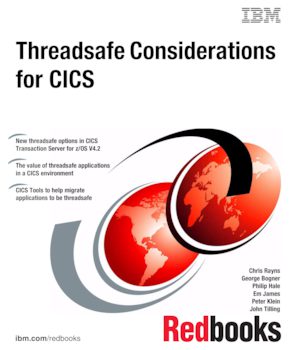
Published on 06 April 2012
Read in Google Books Order hardcopy
Share this page:
ISBN-10: 0738436690
ISBN-13: 9780738436692
IBM Form #: SG24-6351-04
Authors: Chris Rayns, George Bogner, Philip Hale, Em James, Peter Klein and John Tilling
Abstract
Beginning with IBM® CICS® Version 2, applications can run on TCBs apart from the QR TCB, which has positive implications for improving system throughput and for implementing new technologies inside of CICS. Examples of implementing new technologies include using the IBM MVS™ Java virtual machine (JVM) inside CICS and enabling listener tasks written for other platforms to be imported to run under CICS.
The newest release, CICS Transaction Server for z/OS® (CICS TS) V4.2, includes scalability enhancements so that you can perform more work more quickly in a single CICS system. The advantage of this enhancement is that you can increase vertical scaling and decrease the need to scale horizontally, reducing the number of regions that are required to run the production business applications. The scalability enhancements in CICS TS V4.2 fall into two broad areas, which are increased usage of open transaction environment (OTE) and of 64-bit storage.
This IBM Redbooks® publication is a comprehensive guide to threadsafe concepts and implementation for IBM CICS. This book explains how systems programmers, applications developers, and architects can implement threadsafe applications in an environment. It describes the real-world experiences of users, and our own experiences, of migrating applications to be threadsafe. This book also highlights the two most critical aspects of threadsafe applications: system performance and integrity.
Table of Contents
Part 1. Threadsafe concepts and definitions
Chapter 1. Introduction to CICS open transaction environment
Chapter 2. Overview of an open transaction environment and threadsafe applications
Chapter 3. Threadsafe techniques
Part 2. Threadsafe implementation
Chapter 4. Threadsafe tasks
Chapter 5. Application review
Chapter 6. System programmer tasks
Chapter 7. Threadsafe conversion considerations
Chapter 8. Migration scenario
Chapter 9. Threadsafe enablement using CICS Tools
Part 3. Performance and general questions
Chapter 10. Performance case studies
Chapter 11. Common threadsafe questions
Part 4. Appendixes and related publications
Appendix A. Overview of CICS Tools
Appendix B. Maintenance of CICS, DB2, and WebSphere MQ
Appendix C. Assembler routines